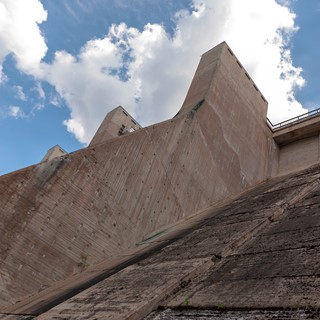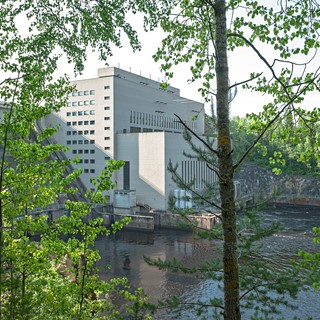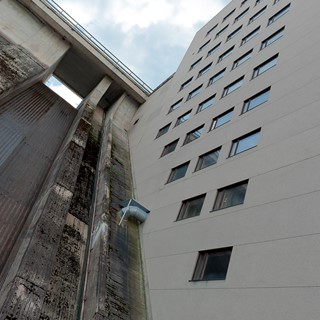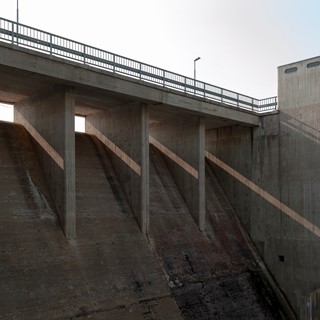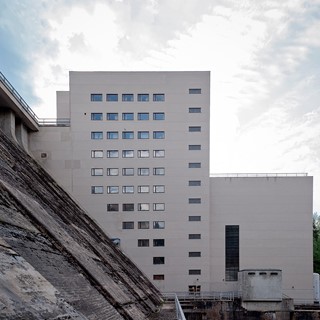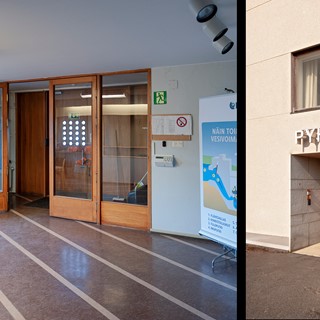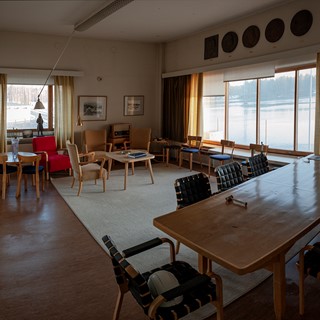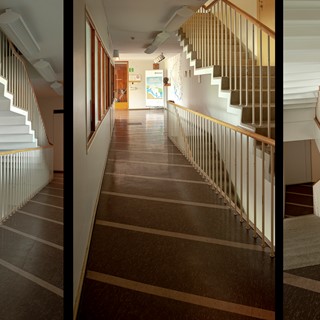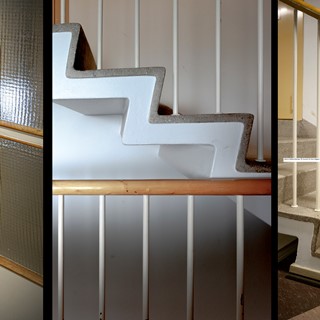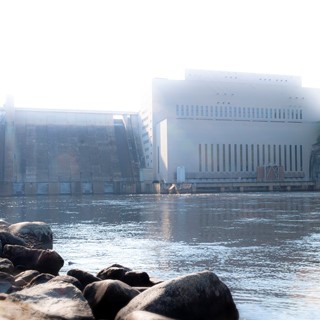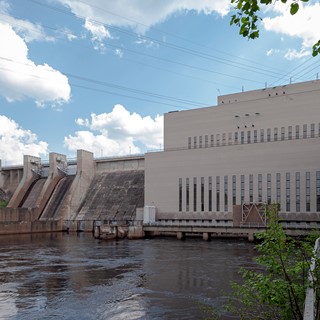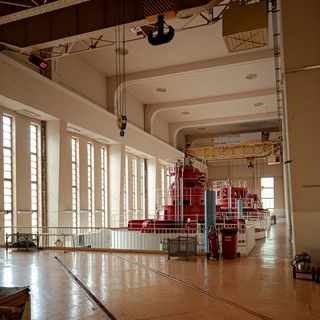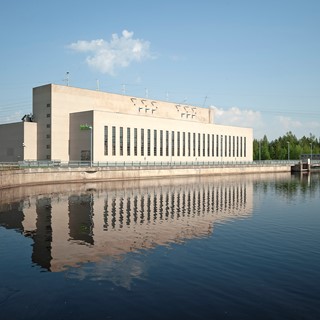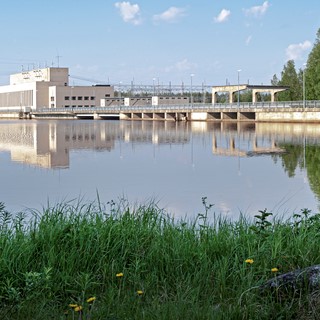Pyhäkoski
Oulujoki Power Company started its giant venture of harnessing the watercourses of the River Oulujoki (the Oulu River) in Pyhäkoski. The construction started in 1941. Because of the Continuation War (1941-1944) it took over ten years to build Pyhäkoski. It is the biggest power plant in the River Oulujoki. Pyhäkoski power plant and Leppiniemi residential area were designed by Aarne Ervi, one of the masters of modern Finnish architecture.
History
Construction of Pyhäkoski started in February 1941, during the Interim Peace. This was before the Oulujoki Power Company was even founded. The construction started by building temporary housing for the builders. A railroad track connecting Hyrkäs and Muhos was also built. In 1941, regulation of the water level of Oulujärvi (Lake Oulujärvi) had also started. The original plan was that the power plant would be finished by 1944 but the material and workforce shortage following the Continuation War slowed the building process.[1]
When the war ended, fall of 1944, the construction continued in full capacity. Rationing of materials was still slowing the construction but things were moving forward. Things that could not be bought, had to be built. Company´s blacksmiths built everything from tools to railroad cars. Conditions got better and the workforce shortage eased during 1947. At that time, an average of 1205-1295 builders worked on the site.[2]
Concrete work for the reservoir was finished in 1948 and the water could be raised to its full regulation height, 32 meters. The machinery was installed after this. The first set of machinery was connected to the power grid in April 1949, the second and third ones in 1951. Nowadays, Pyhäkoski is the fourth largest hydroelectric power plant in Finland.[3]
Because of its presence, size and modernity, Ervi´s power house in Pyhäkoski was considered to be “the Flagship of Oulujoki”. Architecturally, it was an important phase in the development of Finnish modernism and industrial building. [4]
[1] Matti Enbuske. Pohjois-Pohjanmaan ympäristöhistoria. Oulu: Pohjois-Pohjanmaan ELY-keskus ympäristö ja luonnonvarat -vastuualue, 2010, 314
[2] Ibid, 315
[3] Ibid, 315
[4] Turkka Myllykylä. Suomen kulttuurihistoriallisesti arvokkaat sähköä tuottavat vesivoimalaitokset -inventointi 1995-1999. Helsinki: Museovirasto, Fortum Oyj, 1999, 29
Techical information
Owner: Fortum Power and Heat
Finished: 1941-1951
Connected to the power grid: 1951
Designer: Aarne Ervi, architect
Maximum capacity: 147 MW, Head 32.4 meters
Power house: In-situ concrete frame, plastered facade, tall horizontal windows
Special features: Leppiniemi guest house, Power plant museum
Protection status: Classified as RKY (Nationally significant built cultural environment - RKY 2009: Hydropower plants on the River Oulujoki and Sotkamo Route), loval detailed plan Docomomo site [5]
[5] Veli-Pekka Huhmo. Oulujoen vesistön voimalaitosarkkitehtuuria. Oulu: Humanpolis Oy, 2017, 77
Residential area
A completely new housing area was built near the power plant. Leppiniemi, in the municipality of Muhos, was chosen as the location. The area has detached houses, rowhouses and small apartment buildings constructed in the 1940s-1960s. They were meant for the company management, workers and engineers. The most significant building in the area is the Leppiniemi guest house. The area also has a power plant museum. [6]
[6] Veli-Pekka Huhmo. Oulujoen vesistön voimalaitosarkkitehtuuria. Oulu: Humanpolis Oy, 2017, 71
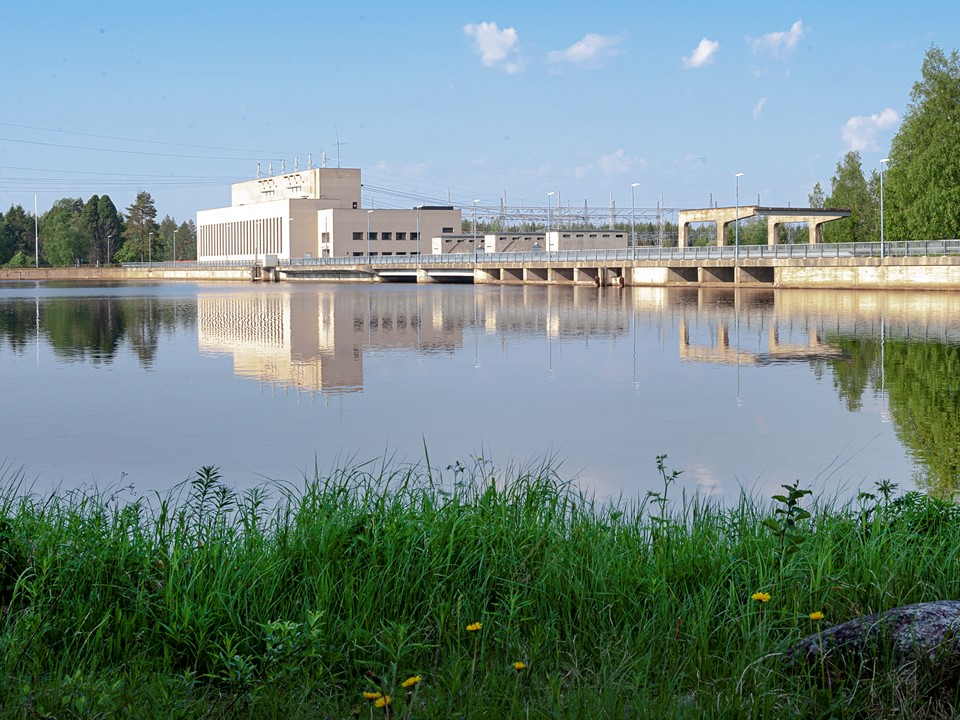
Images
All pictures below are part of the power plant's history. All images are copyrighted. You may use the images for personal use but the images may not be used in commercial contexts or printed matter without our permission. Click on the pictures to enlarge them.
Stories
Here you can read other people's stories about the power plant. And if you have your own story, please share it. Whether you want it to be published on the site or not, we are interested in all stories.
Do you have a story about the powerplant or life around the river?
Send us your story
Visitor information
Below you can read about everything you need to know before a possible visit to the power plant. When it is best to visit the power plant, how to find here and about the rules that apply in the area.

